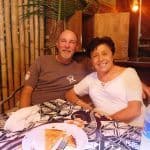The Solomon Islands dive vacation report for Channel Islands Dive Adventures. The trip was in May on the Bilikiki with several extra days spent in Brisbane, Australia.
Recently my wife Tessie and I returned from a trip to the Solomon Islands with a stopover in Brisbane, Australia for 4 days. This was a trip I planned over 2 years ago for my business, Channel Islands Dive Adventures and one thing FOR SURE, we were not disappointed. Of course, there were some changes along the way but Sam and Kellie who own the Bilikiki were the BEST at making it all go very smoothly.
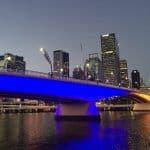 We left Los Angeles on May 12th, arrived in Brisbane early May 14th, and left Brisbane early May 18th for the town of Honiara, the Solomon Islands where we boarded the Bilikiki liveaboard dive boat on the afternoon of May 19th for a 10-day trip around the Solomon Islands. Early on May 29th when our trip was over we had to say goodbye to our new friends and the Bilikiki and travel back to Brisbane staying one extra
We left Los Angeles on May 12th, arrived in Brisbane early May 14th, and left Brisbane early May 18th for the town of Honiara, the Solomon Islands where we boarded the Bilikiki liveaboard dive boat on the afternoon of May 19th for a 10-day trip around the Solomon Islands. Early on May 29th when our trip was over we had to say goodbye to our new friends and the Bilikiki and travel back to Brisbane staying one extra  night till leaving for home on May 30th. Our flights were booked all the way through to the Solomon Islands using Qanta’s which we were very happy with plus getting a luggage allowance of 2 free 50 lbs. bags all the way through was even better. This was not the case with several others who used different airlines for their flights between Brisbane and Honiara because they ended up having to pay around $200.00 extra in overweight charges per flight.
night till leaving for home on May 30th. Our flights were booked all the way through to the Solomon Islands using Qanta’s which we were very happy with plus getting a luggage allowance of 2 free 50 lbs. bags all the way through was even better. This was not the case with several others who used different airlines for their flights between Brisbane and Honiara because they ended up having to pay around $200.00 extra in overweight charges per flight.
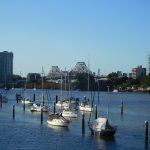 We figured if we flew that far for the trip why not spend some extra time in Brisbane. We did and we loved it staying at an Airbnb condo right in the heart of town! We had fantastic weather in Brisbane with May being an excellent time to visit there. Brisbane is a large modern city with lots of charm from its historic homes and buildings set in
We figured if we flew that far for the trip why not spend some extra time in Brisbane. We did and we loved it staying at an Airbnb condo right in the heart of town! We had fantastic weather in Brisbane with May being an excellent time to visit there. Brisbane is a large modern city with lots of charm from its historic homes and buildings set in  between newer high-rise buildings. It was beautiful with the Brisbane River running through town, lots of green public spaces, gardens, and excellent public transportation with free WIFI in the downtown area. If you plan to stay in Brisbane for several days or more a GoCard that can be purchased at
between newer high-rise buildings. It was beautiful with the Brisbane River running through town, lots of green public spaces, gardens, and excellent public transportation with free WIFI in the downtown area. If you plan to stay in Brisbane for several days or more a GoCard that can be purchased at  any 7-Eleven store is your best bet. It is a pre-loaded card that can be used on buses, trains, and river catamarans. Using it gets you a discounted price plus they have a free travel planner that is very handy to use. You put in where you are and where you would like to go and it will show you what bus to take, what stops, any changes, and how long to get from point A to point B.
any 7-Eleven store is your best bet. It is a pre-loaded card that can be used on buses, trains, and river catamarans. Using it gets you a discounted price plus they have a free travel planner that is very handy to use. You put in where you are and where you would like to go and it will show you what bus to take, what stops, any changes, and how long to get from point A to point B.
 In Brisbane, the Lone Pine Kola Sanctuary is probably the main tourist destination and one not to miss. Probably the most enjoyable way to go is the Mirimar boat tour traveling up the river while getting a very Australian commentary. The Kola sanctuary opened in 1927 as a safe refuge for sick, injured, orphaned
In Brisbane, the Lone Pine Kola Sanctuary is probably the main tourist destination and one not to miss. Probably the most enjoyable way to go is the Mirimar boat tour traveling up the river while getting a very Australian commentary. The Kola sanctuary opened in 1927 as a safe refuge for sick, injured, orphaned 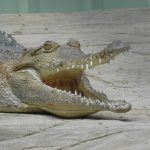 Kolas and other animals and it was a highlight of our trip. Not only can you see Kolas up close and personal and get your picture with one but you can feed the kangaroos, watch a raptor and sheepdog show and see some other native Australian animals.
Kolas and other animals and it was a highlight of our trip. Not only can you see Kolas up close and personal and get your picture with one but you can feed the kangaroos, watch a raptor and sheepdog show and see some other native Australian animals.
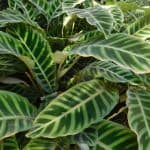 We equally liked exploring the downtown and going to the free city gardens and free Mt Coot-Tha Botanic Gardens where we had the BEST private tour ever. We could have easily gone back a second day to experience the Planetarium and more of the gardens but unfortunately, we were out of time having to fly to Honiara the next morning.
We equally liked exploring the downtown and going to the free city gardens and free Mt Coot-Tha Botanic Gardens where we had the BEST private tour ever. We could have easily gone back a second day to experience the Planetarium and more of the gardens but unfortunately, we were out of time having to fly to Honiara the next morning.
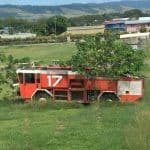 Friday afternoon we arrived in Honiara, the capital of the Solomon Islands, and on the island of Guadalcanal. We arrived just in time for the rush hour traffic. Good thing we didn’t have to drive because it was chaotic in a perfectly normal way. The roads were being worked on so lots of dust, potholes, and people everywhere
Friday afternoon we arrived in Honiara, the capital of the Solomon Islands, and on the island of Guadalcanal. We arrived just in time for the rush hour traffic. Good thing we didn’t have to drive because it was chaotic in a perfectly normal way. The roads were being worked on so lots of dust, potholes, and people everywhere 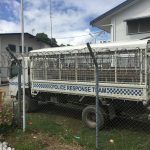 walking in the heat. I will have to say Honiara isn’t the type of town you go to visit but while there you can take in a tour of World War ll sites and memorials or get some diving into some of the World War ll wrecks. Honiara is also a jumping-off point to other islands for scuba trips and eco lodging.
walking in the heat. I will have to say Honiara isn’t the type of town you go to visit but while there you can take in a tour of World War ll sites and memorials or get some diving into some of the World War ll wrecks. Honiara is also a jumping-off point to other islands for scuba trips and eco lodging.
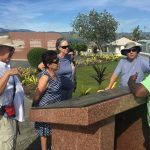 While in Honiara we did take a 3-hour World War ll tour seeing where lots of the battles took place and visiting a few of the memorials. We also went to the town market where the locals sell the produce they grow on their farms and the jewelry and other things they make. I will say they
While in Honiara we did take a 3-hour World War ll tour seeing where lots of the battles took place and visiting a few of the memorials. We also went to the town market where the locals sell the produce they grow on their farms and the jewelry and other things they make. I will say they 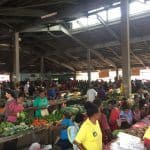 are very resourceful! While in Honiara we stayed at the King Solomon hotel which is built on a hill with a cable car moving you up the hill to all the different levels. It was nothing fancy and more like a 2.5-star
are very resourceful! While in Honiara we stayed at the King Solomon hotel which is built on a hill with a cable car moving you up the hill to all the different levels. It was nothing fancy and more like a 2.5-star 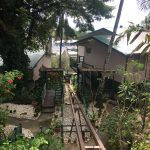 hotel in the states. Food was good, drinks cold, they had good entertainment (but loud) and the AC worked in our room so it worked out for us. I would love to do another trip with the Bilikiki and when I do I will pay a few dollars extra and stay in a nicer hotel with working Wi-Fi like the Solomon Kitano Mendana Hotel or the Coral Sea resort.
hotel in the states. Food was good, drinks cold, they had good entertainment (but loud) and the AC worked in our room so it worked out for us. I would love to do another trip with the Bilikiki and when I do I will pay a few dollars extra and stay in a nicer hotel with working Wi-Fi like the Solomon Kitano Mendana Hotel or the Coral Sea resort.
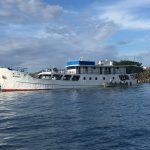 Finally, it was Saturday afternoon, May 19th, and time for the Bilikiki crew to pick us all up from our hotels and the airport and transfer us to the boat. It was hot out and getting to the boat on the water couldn’t come any sooner.
Finally, it was Saturday afternoon, May 19th, and time for the Bilikiki crew to pick us all up from our hotels and the airport and transfer us to the boat. It was hot out and getting to the boat on the water couldn’t come any sooner. 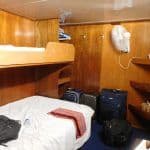 Once on the boat, we were welcomed with some drinks, snacks, a quick briefing, and some introductions as we had 8 others not part of our group and we settled into our cabins. The cabins were nice with some having two beds side by side with a space between them and some had the usual upper and lower bunks. Each room had plenty of storage and your own bathroom and shower.
Once on the boat, we were welcomed with some drinks, snacks, a quick briefing, and some introductions as we had 8 others not part of our group and we settled into our cabins. The cabins were nice with some having two beds side by side with a space between them and some had the usual upper and lower bunks. Each room had plenty of storage and your own bathroom and shower.
 My wife is a non-diver and the first thing she said to me as we walked around on the boat was “this boat is one of the cleanest” and she was right. The Bilikiki
My wife is a non-diver and the first thing she said to me as we walked around on the boat was “this boat is one of the cleanest” and she was right. The Bilikiki 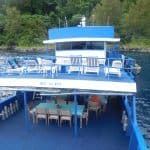 started her life as a fishing vessel (part of the tuna fleet) and was later converted to a cargo vessel for a bit traveling around the Solomon Island. Eventually, she was bought and turned into a first-class liveaboard dive operation. She had 10 passenger staterooms built within the cargo hold, compressors added, dive deck built, dining
started her life as a fishing vessel (part of the tuna fleet) and was later converted to a cargo vessel for a bit traveling around the Solomon Island. Eventually, she was bought and turned into a first-class liveaboard dive operation. She had 10 passenger staterooms built within the cargo hold, compressors added, dive deck built, dining  area and inside salon built, and many other conversions and modifications done to make her an outstanding liveaboard which she still is today. She started sailing in 1989 and consistently is rated one of the best liveaboards in the world. She is 125’ x 24’, has 3 main decks, and runs with a 12-man crew most of which have been working on the Bilikiki for many years and all do an excellent job especially our cooks.
area and inside salon built, and many other conversions and modifications done to make her an outstanding liveaboard which she still is today. She started sailing in 1989 and consistently is rated one of the best liveaboards in the world. She is 125’ x 24’, has 3 main decks, and runs with a 12-man crew most of which have been working on the Bilikiki for many years and all do an excellent job especially our cooks.
 Every day to start there was a continental breakfast out as well as hot stuff such as eggs, sausage, or bacon. There were always snacks between dives like fresh baked cookies and popcorn. For lunch, they always had freshly made soups (some of the best), pasta, fish, tacos, lasagna, etc. For dinner, they would set the tables up with nice dinnerware and have steaks, fish, lobster, pasta, and more. After dinner, we had homemade desserts of which
Every day to start there was a continental breakfast out as well as hot stuff such as eggs, sausage, or bacon. There were always snacks between dives like fresh baked cookies and popcorn. For lunch, they always had freshly made soups (some of the best), pasta, fish, tacos, lasagna, etc. For dinner, they would set the tables up with nice dinnerware and have steaks, fish, lobster, pasta, and more. After dinner, we had homemade desserts of which 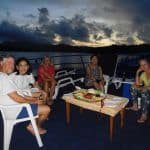 Steven thoroughly enjoyed. Every evening before dinner on the top deck they had an assortment of appetizers making it very hard for me to not eat too much. Everything was homemade with fresh ingredients with all the produce coming from the villagers. The crew were always trolling for fish while the boat was traveling so we had lots of really tasty fresh fish along the way. The cooks were creative and did an excellent job at keeping us all very happy!
Steven thoroughly enjoyed. Every evening before dinner on the top deck they had an assortment of appetizers making it very hard for me to not eat too much. Everything was homemade with fresh ingredients with all the produce coming from the villagers. The crew were always trolling for fish while the boat was traveling so we had lots of really tasty fresh fish along the way. The cooks were creative and did an excellent job at keeping us all very happy!
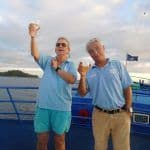 The boat doesn’t have divemasters like other boats usually do but they go one step further and have a pair of managers who usually stay on the boat for a number of years. Our managers were Tina & Oli who have been the current managers for the past 2 years and do an excellent job of it. They run the show and have MANY duties such as figuring everything out, scheduling dives, conducting the detailed briefings, acting as the
The boat doesn’t have divemasters like other boats usually do but they go one step further and have a pair of managers who usually stay on the boat for a number of years. Our managers were Tina & Oli who have been the current managers for the past 2 years and do an excellent job of it. They run the show and have MANY duties such as figuring everything out, scheduling dives, conducting the detailed briefings, acting as the  divemaster’s, taking care of buying all the fresh produce from the locals and arranging all the cultural trips trying to make each village happy. The Bilikiki has been operating for over 20 years in the Solomon Islands and doing this takes much finesse because not all the villages seem to get along just like any other place in the world.
divemaster’s, taking care of buying all the fresh produce from the locals and arranging all the cultural trips trying to make each village happy. The Bilikiki has been operating for over 20 years in the Solomon Islands and doing this takes much finesse because not all the villages seem to get along just like any other place in the world.
 Since the very beginning, the Bilikiki has tried their best to keep good relations between the villages and them. One way they do this is by handing out seeds to the local villagers. This not only creates a source of income for the villages but it also helps in getting fresh fruit and vegetables during the trips. They also pay to dive on the reefs visited. Traditionally all land and the adjoining reef are owned by the tribes of the area and controlled by the local chief. Paying to dive means that Bilikiki is always welcome and provides incentives for villagers to protect their reefs as much as possible.
Since the very beginning, the Bilikiki has tried their best to keep good relations between the villages and them. One way they do this is by handing out seeds to the local villagers. This not only creates a source of income for the villages but it also helps in getting fresh fruit and vegetables during the trips. They also pay to dive on the reefs visited. Traditionally all land and the adjoining reef are owned by the tribes of the area and controlled by the local chief. Paying to dive means that Bilikiki is always welcome and provides incentives for villagers to protect their reefs as much as possible.
 Talking to everyone on our trip it seems one of the MAIN reasons for a 10-day Bilikiki trip is not only the diving but also the cultural experience you get as well by visiting the local villages and having the chance to see their traditional singing and dancing and to buy handmade carvings made by the villagers.
Talking to everyone on our trip it seems one of the MAIN reasons for a 10-day Bilikiki trip is not only the diving but also the cultural experience you get as well by visiting the local villages and having the chance to see their traditional singing and dancing and to buy handmade carvings made by the villagers.
 This gives them much needed income and a chance to show off their cultural heritage. Carving is the main economic activity for many people in Marovo Lagoon and getting the opportunity to buy their handmade art is a highlight for many. I know we spent more than planned but it was WORTH it! Unfortunately on a 7 day trip the Bilikiki does not travel as far so you do not get to Marovo Lagoon.
This gives them much needed income and a chance to show off their cultural heritage. Carving is the main economic activity for many people in Marovo Lagoon and getting the opportunity to buy their handmade art is a highlight for many. I know we spent more than planned but it was WORTH it! Unfortunately on a 7 day trip the Bilikiki does not travel as far so you do not get to Marovo Lagoon.
The Bilikiki also runs annual medical trips with the Loloma Foundation who provides nurses, doctors, dentists, and supplies so that Bilikiki can be turned into a floating hospital for a week or two. It is a great opportunity for people in the areas in which they dive to get health care that they would not normally have access to.
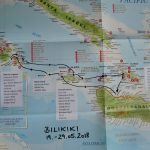 So now onto our trip! We started our first day of the trip, Sunday, May 20th in the Russell Islands, diving one of the most photographed places in all the Solomon Islands, Leru Cut with beams of light coming down through the top and we did Elephant Reef with the biggest Elephant Ear sponges I have ever seen. Turns out for the night dive I was the only one who wanted to go so I won myself a free beer by staying dry.
So now onto our trip! We started our first day of the trip, Sunday, May 20th in the Russell Islands, diving one of the most photographed places in all the Solomon Islands, Leru Cut with beams of light coming down through the top and we did Elephant Reef with the biggest Elephant Ear sponges I have ever seen. Turns out for the night dive I was the only one who wanted to go so I won myself a free beer by staying dry.
 On Monday we moved to Mary Island. Some of my favorite sites here were Barracuda Point and Bilikiki Bay. At Barracuda Point you could hear the sound of the Kavachi volcano underwater which was very cool. My wife and I snorkeled Bilikiki Bay plus I did a beautiful dive there enjoying the diverse hard and soft corals while finding some cool-looking nudibranchs.
On Monday we moved to Mary Island. Some of my favorite sites here were Barracuda Point and Bilikiki Bay. At Barracuda Point you could hear the sound of the Kavachi volcano underwater which was very cool. My wife and I snorkeled Bilikiki Bay plus I did a beautiful dive there enjoying the diverse hard and soft corals while finding some cool-looking nudibranchs.
 After Mary Island, we then moved to Marovo Lagoon. The lagoon is very large and has so much diversity that we spent Tuesday, Wednesday and Thursday there having some outstanding dives and visiting the Mbili, Luten’s, and Peava wood carving markets.
After Mary Island, we then moved to Marovo Lagoon. The lagoon is very large and has so much diversity that we spent Tuesday, Wednesday and Thursday there having some outstanding dives and visiting the Mbili, Luten’s, and Peava wood carving markets.
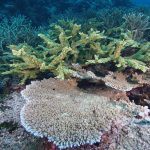 Marovo Lagoon is where I saw some of the best and most diverse hard corals I have ever seen. Some of my favorite sites where Kicha and Mbulo Canyons. Kicha was not only an excellent site with all the hard corals at the end that looked like a Japanese garden but it was also very close to the Kavachi volcano and while on the dive when the volcano boomed you could feel the pressure making it feel like you were sitting next to the loudest bass speaker ever.
Marovo Lagoon is where I saw some of the best and most diverse hard corals I have ever seen. Some of my favorite sites where Kicha and Mbulo Canyons. Kicha was not only an excellent site with all the hard corals at the end that looked like a Japanese garden but it was also very close to the Kavachi volcano and while on the dive when the volcano boomed you could feel the pressure making it feel like you were sitting next to the loudest bass speaker ever.
 On Tuesday morning, our first day in the lagoon we visited the Mbili and Lutens wood carving markets on two different islands. The villagers not only carve beautiful figures and bowls inlaid with other woods and shells but they also weave some very pretty baskets, trays, and hotplate type of things. They are very talented and it shows in their craftsmanship. BEWARE because you could spend all your money and there is still another market to visit in a couple of days.
On Tuesday morning, our first day in the lagoon we visited the Mbili and Lutens wood carving markets on two different islands. The villagers not only carve beautiful figures and bowls inlaid with other woods and shells but they also weave some very pretty baskets, trays, and hotplate type of things. They are very talented and it shows in their craftsmanship. BEWARE because you could spend all your money and there is still another market to visit in a couple of days.
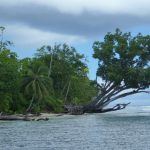 Later in the day, the crew tied up the Bilikiki to an area of Wickham Island. My wife and I went snorkeling for about an hour. I kept looking to see where the boat was and towards the end of our snorkel I looked back and everyone was yelling and waving for us to come in. We were snorkeling while the others were out diving so the first thing that came to my mind was something happened. I held my wife’s hand with a strong grip and kicked back to the boat quickly. Once on the boat, I asked what happened and they said they saw a large crocodile out in the water not far from us. Good thing they were watching because we might have ended up being dinner for the croc.
Later in the day, the crew tied up the Bilikiki to an area of Wickham Island. My wife and I went snorkeling for about an hour. I kept looking to see where the boat was and towards the end of our snorkel I looked back and everyone was yelling and waving for us to come in. We were snorkeling while the others were out diving so the first thing that came to my mind was something happened. I held my wife’s hand with a strong grip and kicked back to the boat quickly. Once on the boat, I asked what happened and they said they saw a large crocodile out in the water not far from us. Good thing they were watching because we might have ended up being dinner for the croc.
 The following day on Wednesday we dived the Iwami Maru that was a wreck from World War ll. It was a Japanese freighter that was about 180 ft. long and was sunk on December 26, 1942. It sits upright and in good condition with the stern and mid-section damaged from being bombed. It sunk near a Japanese base located within the Lagoon. The cool
The following day on Wednesday we dived the Iwami Maru that was a wreck from World War ll. It was a Japanese freighter that was about 180 ft. long and was sunk on December 26, 1942. It sits upright and in good condition with the stern and mid-section damaged from being bombed. It sunk near a Japanese base located within the Lagoon. The cool 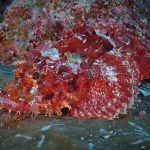 attraction on this wreck is a wheeled cannon that now sits atop the side rail on the starboard side of the bow. Later in the afternoon, the Bilikiki moved in close to one of the islands for a routine stop to get water which was an all-night process. With only a hose about 3” in diameter and no pumps it takes a long time but no worries because they have it all planned out.
attraction on this wreck is a wheeled cannon that now sits atop the side rail on the starboard side of the bow. Later in the afternoon, the Bilikiki moved in close to one of the islands for a routine stop to get water which was an all-night process. With only a hose about 3” in diameter and no pumps it takes a long time but no worries because they have it all planned out.
 One thing I think most divers don’t realize (myself included) is that when we think of the Solomon Islands we think of diving lots of wrecks but that isn’t the case. There are wrecks but either very deep like the ones in the Iron Bottom Sound between Guadalcanal and the Florida Islands or they are off the beaten path enough that the Bilikiki doesn’t visit them. If you are looking for a wreck trip then you will need to check out some of the land-based resorts in Morovo Lagoon.
One thing I think most divers don’t realize (myself included) is that when we think of the Solomon Islands we think of diving lots of wrecks but that isn’t the case. There are wrecks but either very deep like the ones in the Iron Bottom Sound between Guadalcanal and the Florida Islands or they are off the beaten path enough that the Bilikiki doesn’t visit them. If you are looking for a wreck trip then you will need to check out some of the land-based resorts in Morovo Lagoon.
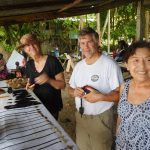 Thursday morning the 24th we started the day early with a visit to the Peava carving market that was very close to the boat. Personally, I think this was one of the best markets because the villagers had so much variety to look at and of course we did not go back to the boat empty handed. I brought 3 masks and 5 snorkels to give away but
Thursday morning the 24th we started the day early with a visit to the Peava carving market that was very close to the boat. Personally, I think this was one of the best markets because the villagers had so much variety to look at and of course we did not go back to the boat empty handed. I brought 3 masks and 5 snorkels to give away but 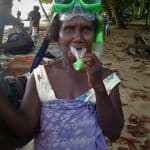 here I was able to barter and I traded a lime green snorkel and mask along with some cash for a tray that was weaved with local plants. The lady I bought it from said the mask and snorkel were for her husband but as soon as we were ready to leave she was walking around all proud looking with it on her head so Ralph and I jumped out and were able to get a few pictures with her. That seemed to really make the day for the villagers.
here I was able to barter and I traded a lime green snorkel and mask along with some cash for a tray that was weaved with local plants. The lady I bought it from said the mask and snorkel were for her husband but as soon as we were ready to leave she was walking around all proud looking with it on her head so Ralph and I jumped out and were able to get a few pictures with her. That seemed to really make the day for the villagers.
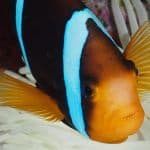 Later that day during our travels we visited the dive site Kicha. This was not only an excellent and beautiful site with all the hard corals at the end that looked like a Japanese garden but it was also much closer to the Kavachi volcano than our earlier dive at Barracuda Point. During the dive when the volcano boomed you could hear the sound and feel the pressure wave making it feel like you were sitting next to the loudest bass speaker ever, much stronger than at Barracuda Point.
Later that day during our travels we visited the dive site Kicha. This was not only an excellent and beautiful site with all the hard corals at the end that looked like a Japanese garden but it was also much closer to the Kavachi volcano than our earlier dive at Barracuda Point. During the dive when the volcano boomed you could hear the sound and feel the pressure wave making it feel like you were sitting next to the loudest bass speaker ever, much stronger than at Barracuda Point.
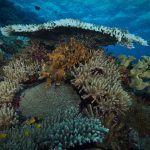 That afternoon they tied up the Bilikiki for the night at Mbulo Canyons where I did a really nice hour-long snorkel with my wife and some awesome dives. After I thought I saw the best hard corals EVER at Bilikiki Bay there was Mbulo Canyons. It was so nice I wanted to rename this site the Magical Forrest!
That afternoon they tied up the Bilikiki for the night at Mbulo Canyons where I did a really nice hour-long snorkel with my wife and some awesome dives. After I thought I saw the best hard corals EVER at Bilikiki Bay there was Mbulo Canyons. It was so nice I wanted to rename this site the Magical Forrest!
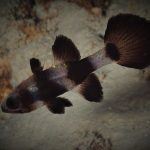 I also had a very interesting night dive here with my buddy Ray and Oli. Oli wanted to show us two special fish, the Paddlefish and the Flashlight fish. Both required us to not use our lights and follow the tank light that Oli had. We went through channels in the reef sort of like large coral cuts in Cozumel. We found the paddlefish which just stayed motionless when you
I also had a very interesting night dive here with my buddy Ray and Oli. Oli wanted to show us two special fish, the Paddlefish and the Flashlight fish. Both required us to not use our lights and follow the tank light that Oli had. We went through channels in the reef sort of like large coral cuts in Cozumel. We found the paddlefish which just stayed motionless when you 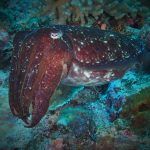 shined your light on them. The Flashlight fish was another story. We never did find one and at one point Oli motioned his light in a side entrance for me to go in. I did and I turned off all my lights looking for the fish. Both Ray and Oli had their lights off as well but after what seemed like 5 minutes I turned around and no one was there. I found them a short distance away giving Oli a scare (not me). We never saw the fish but the cool thing was, I seen an incredible light show while in the dark from the bioluminescent when touching the wall of the cavern.
shined your light on them. The Flashlight fish was another story. We never did find one and at one point Oli motioned his light in a side entrance for me to go in. I did and I turned off all my lights looking for the fish. Both Ray and Oli had their lights off as well but after what seemed like 5 minutes I turned around and no one was there. I found them a short distance away giving Oli a scare (not me). We never saw the fish but the cool thing was, I seen an incredible light show while in the dark from the bioluminescent when touching the wall of the cavern.
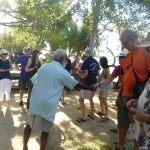 Very early Friday morning we traveled back to the Russell Islands spending both Friday and Saturday there. We started Friday morning off with a dive and then a visit to the village of Karumolun. Here we were greeted by the chief and given beautiful leis by the younger village girls. In Karumolun we also watched an unforgettable performance of
Very early Friday morning we traveled back to the Russell Islands spending both Friday and Saturday there. We started Friday morning off with a dive and then a visit to the village of Karumolun. Here we were greeted by the chief and given beautiful leis by the younger village girls. In Karumolun we also watched an unforgettable performance of  dancing and pan pipe music and were treated to a tour of the island by the chief. I really liked the panpipe music, especially because the kids are very resourceful and made the pipes from different size PVC pipe and using old flip flops as a sort of drumstick. See the link below for the village visit video.
dancing and pan pipe music and were treated to a tour of the island by the chief. I really liked the panpipe music, especially because the kids are very resourceful and made the pipes from different size PVC pipe and using old flip flops as a sort of drumstick. See the link below for the village visit video.
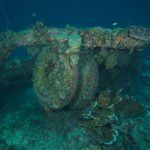 After all the village fun we did another dive and then moved to White Beach for the rest of the day. White Beach was a key American re-provisioning area during WWII for the resupplying of large military ships. When the US Military left, they pushed much of the machinery such as trucks, jeeps, bulldozers, and equipment off the end of the portable piers into the ocean because they not only couldn’t transport them out in time but this way no one could use them against the US. As it all slid down the sloping wall it settled making new reefs and plenty for us to explore making it an excellent dive site.
After all the village fun we did another dive and then moved to White Beach for the rest of the day. White Beach was a key American re-provisioning area during WWII for the resupplying of large military ships. When the US Military left, they pushed much of the machinery such as trucks, jeeps, bulldozers, and equipment off the end of the portable piers into the ocean because they not only couldn’t transport them out in time but this way no one could use them against the US. As it all slid down the sloping wall it settled making new reefs and plenty for us to explore making it an excellent dive site.
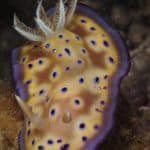 Saturday we did 4 dives and one of the sites was Fonagho where we had a surprise visit of a big hammerhead shark and of course I missed that one completely. Diving the Solomon Islands isn’t about seeing big stuff although occasionally we did have some sharks visit us at a few of the dive sites while keeping their distance from us.
Saturday we did 4 dives and one of the sites was Fonagho where we had a surprise visit of a big hammerhead shark and of course I missed that one completely. Diving the Solomon Islands isn’t about seeing big stuff although occasionally we did have some sharks visit us at a few of the dive sites while keeping their distance from us.
That evening we moved again for our last two days diving around the Florida Islands. We had some really great dives in this area and some of my favorites were Velvia, Devil’s Highway, and the Mavis Seaplane.
 Velvia was named after the old Velvia slide film and this site was very colorful with lots of different colored feather star crinoids. In fact, these were all over the Solomon Islands but this site seemed to have the most diversity of them. I also saw a banded sea snake at this site which was a first for me.
Velvia was named after the old Velvia slide film and this site was very colorful with lots of different colored feather star crinoids. In fact, these were all over the Solomon Islands but this site seemed to have the most diversity of them. I also saw a banded sea snake at this site which was a first for me.
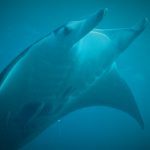 After Velvia, we did the Devil’s Highway which was an awesome dive! Here we flew in a FAST current for a short ride to a ledge where we found good seating and watched Mantas swim by us to feed and at one point I could see up to 6 even though there were maybe around 10. What a cool dive this was as we sat for over an hour just watching them glide by.
After Velvia, we did the Devil’s Highway which was an awesome dive! Here we flew in a FAST current for a short ride to a ledge where we found good seating and watched Mantas swim by us to feed and at one point I could see up to 6 even though there were maybe around 10. What a cool dive this was as we sat for over an hour just watching them glide by.
 Monday was a sad day as it was our last day to dive. We did Twin Tunnels which was an old crater with 2 very LARGE lava tubes next to each other starting at around 40’ and connecting to one main tube at 120’ that exited out the side of the crater. It was a very cool dive with lots of hard corals, clownfish, and a few sharks off in the distance.
Monday was a sad day as it was our last day to dive. We did Twin Tunnels which was an old crater with 2 very LARGE lava tubes next to each other starting at around 40’ and connecting to one main tube at 120’ that exited out the side of the crater. It was a very cool dive with lots of hard corals, clownfish, and a few sharks off in the distance.
 Our second and last dive of the trip for most everyone was the Japanese Mavis Seaplane, sunk in August 1942. During WW ll the Japanese’s had a seaplane base located on the island of Tulagi and here there were 7 seaplanes sunk during a bombing raid by the US Navy. The seaplane we dived was off Tanambogo Island and still in a rather good shape after the many years it has been underwater. Most of it sits between 85’-100’ on a sandy bottom with a shallow reef nearby. Because of the sand and being in a bay, the visibility was not so good but it was still an excellent dive.
Our second and last dive of the trip for most everyone was the Japanese Mavis Seaplane, sunk in August 1942. During WW ll the Japanese’s had a seaplane base located on the island of Tulagi and here there were 7 seaplanes sunk during a bombing raid by the US Navy. The seaplane we dived was off Tanambogo Island and still in a rather good shape after the many years it has been underwater. Most of it sits between 85’-100’ on a sandy bottom with a shallow reef nearby. Because of the sand and being in a bay, the visibility was not so good but it was still an excellent dive.
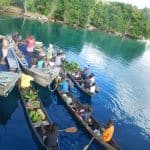 I had never been on a 10-day liveaboard trip and wasn’t sure how it would be but with all the diving and cultural things to do the time went by very quickly and everyone went at their own pace. If you did every dive which no one did we could have done 39 dives. I did 31 dives and 6 one hour long snorkels with my wife getting plenty of underwater time in. Probably the average for everyone was more like around 25 dives. Most all my dives were
I had never been on a 10-day liveaboard trip and wasn’t sure how it would be but with all the diving and cultural things to do the time went by very quickly and everyone went at their own pace. If you did every dive which no one did we could have done 39 dives. I did 31 dives and 6 one hour long snorkels with my wife getting plenty of underwater time in. Probably the average for everyone was more like around 25 dives. Most all my dives were 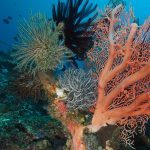 50-70 minutes long and the deepest was coming out of the Twin Tunnels lava tube at around 117’. Some dives were no more than 40’-50’ deep and there were other dives I would have been happy to have been able to spend 2 hours in no more than 30’ of water. Visibility during the trip varied depending on where we were but probably averaged a good 75’-100’. Of course when in the bays and lagoons it dropped but never below 30’.
50-70 minutes long and the deepest was coming out of the Twin Tunnels lava tube at around 117’. Some dives were no more than 40’-50’ deep and there were other dives I would have been happy to have been able to spend 2 hours in no more than 30’ of water. Visibility during the trip varied depending on where we were but probably averaged a good 75’-100’. Of course when in the bays and lagoons it dropped but never below 30’.
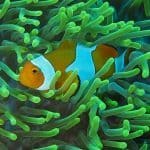 Most of what we saw was smaller stuff such as some nudibranchs, lots of different fish in big schools, some eels, some sharks but way off in the distance, the smaller mantas at the Devil’s Highway, LOTS of different clownfish on just about every dive, plenty of the feather stars in all colors, the most diverse hard corals, some soft corals, small shrimp and crabs and more.
Most of what we saw was smaller stuff such as some nudibranchs, lots of different fish in big schools, some eels, some sharks but way off in the distance, the smaller mantas at the Devil’s Highway, LOTS of different clownfish on just about every dive, plenty of the feather stars in all colors, the most diverse hard corals, some soft corals, small shrimp and crabs and more.
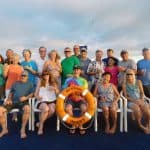 The Bilikiki has accommodations for 20 passengers. We had 11 in our group (Cindi, Steven, Bruce, Howard, Emily, Chantal, Debbie, Jan, Ray, and my wife and I. One (Ryan) could not make it at the last minute. Everyone from the CIDA group was from Southern California except for Chantal who is from Montreal, Quebec.
The Bilikiki has accommodations for 20 passengers. We had 11 in our group (Cindi, Steven, Bruce, Howard, Emily, Chantal, Debbie, Jan, Ray, and my wife and I. One (Ryan) could not make it at the last minute. Everyone from the CIDA group was from Southern California except for Chantal who is from Montreal, Quebec.
 We had another 8 join us. Dan, Matt, Jan, Marc, Denise, and Jon were all from Hawaii, Ralph was from Southern California and Bill who I believe was from Virginia.
We had another 8 join us. Dan, Matt, Jan, Marc, Denise, and Jon were all from Hawaii, Ralph was from Southern California and Bill who I believe was from Virginia.
After any trip, the MAIN question I always ask myself is? How did I like it and would I go back? That would be I LOVED it and YES in a heartbeat!!!
By Ken Kollwitz
Check out our Scuba Vacations page for more Channel Islands Dive Adventures trips.
Flickr link to topside photos
Flickr link to underwater photos
Flickr link to Brisbane & Honiara photos
Video of our Before Trip Adventure in Brisbane & Honiara
Video of our Village Visit
Video to hear the Kavachi volcano underwater
Video of our Topside Adventure
Video of Below the Surface
By Ken Kollwitz
